Notice: This web page is constantly in a state of flux and fact-checking is by no means complete. Use the content at your own peril. From conception, it has been an effort to consolidate as much information as possible from any credible sources. If you have any photos of fifes with a known provenance, I will be very happy to add them to the page for the benefit of all.
How old is my fife?
I frequently receive emails from fifers, often containing photographs, the writer asking me how old their fife is. Much of the time, my answer is simply, "I don't know." It is a very difficult question, compounded by the fact that nothing much has ever been published on the subject, particularly with photographs, diagrams or illustrations. Throughout American history, fifes could be made from every kind of wood by anybody who had a lathe. Some were instrument makers and others were rank amateurs who only made a few. From early America through the Civil War, even the major makers did not always label their fifes, so it often comes down to comparing one with another when the "known" doesn't always have a substantial pedigree. I have many fifes in my personal collection that I would like to identify. Usually there is little to no significant provenance or history that is backed up by documentation of any kind. Even markings of military units can be grossly misleading, often made on post-war fifes merely to identify the owners. Many museums have the very same problem. This article is an attempt to lay down what is known. The history written here has some holes in it, as does the story. For the time being, my search is confined to the wooden 6 hole keyless fife. Maybe visitors can offer additional information, so please consider it to be a work in progress, and by no means definitive. Email Me if you have anything to add or correct. Photos of unusual and especially maker-marked fifes would be helpful as well.
During the early 18th century, fifes played in America were either locally made or imported from England. I have never seen a verified fife from this period nor have I heard of any that have survived. However, I have seen fifes that were extremely old and may date to the 18th century. They were obviously very old and made from Maple, Walnut, Cherry, Coccus and Boxwood. There is evidence that a Major Jonathan Gostelow delivered 163 fifes to the Continental Army in August of 1780. His firm also made drums, but it cannot be confirmed that Gostelow actually made the fifes. Although it was before his time, it is conceivable that they were made by William Callender, who would have been age 24 at the time. Callender, born in 1756, made woodwinds, including fifes, between 1796 and 1825. Some European fife makers of the period were W. Camp, Cahusac, Button & Purday, Astor and others. Below are two William Callender fifes, one of boxwood and one of black ebony.
![]()
![]()

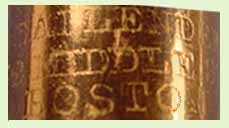

The ebony Callender fife above is marked "62 Middle Street, Boston," which was where his shop was located from 1803 to 1818. It has seamed ferrules and uses the simple fingering system.
Here is a Cahusac fife from around 1780:
![]()
Here is an Oppenheim fife made in London around 1790. Made of Boxwood, the ferrules were attached by punching on the inside score lines.
![]()
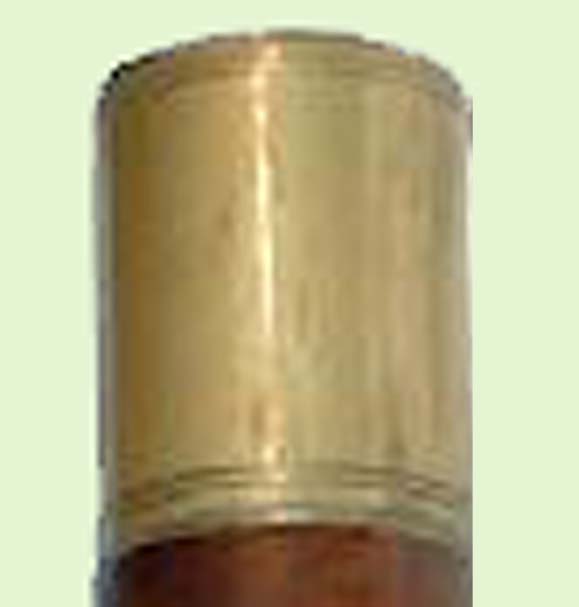
At the end of the War of Independence, soldiers were permitted to take their muskets home with them. Since musicians were generally unarmed throughout the war, General Washington issued specific orders permitting musicians to keep their fifes and drums instead of weapons. Considering this fact, it is amazing that so few instruments from that period have survived to date.
In 1824, Samuel Graves founded a musical instrument manufactory in West Fairlee, Vermont, and in 1830 expanded the business into a 4 story shop in Winchester, New Hampshire. At that site, a dam and waterwheel made plenty of power available for expanded production. Fifes, flutes, piccolos, and clarinets were the principal products produced there. In 1850, a fire destroyed the plant and the Graves family moved the firm to Boston, where they focused on brass instruments until the firm went out of business in 1878. Below is a Graves fife, courtesy of Jack Doyle.

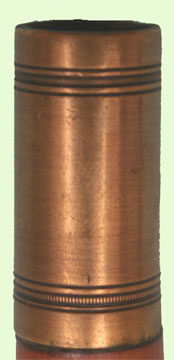
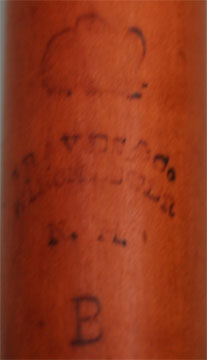
Made of boxwood and made sometime in the1830s, the Graves fife has two unusual chracteristics: It is in the key of B natural and the scribing pattern on both ferrules is 4 + 0 + 4.
Between 1819 and 1880, Klemm & Brothers made fifes in both Philadelphia and in Germany and was a major supplier during the Civil War. They rarely marked their fifes, or the markings commonly wore off. All Klemm fifes that I have seen so far have the simple fingering system. Below is a marked boxwood fife by Klemm. The marking states "Klemm, Philadelphia."

And another:
![]()

Here
is another marked Klemm Bb instrument made from Grenadilla:

The next fife is a "C" instrument by Klemm, courtesy of Chris Nelson. It is marked "Klemm & Bro - Philadelphia." Klemm fifes are notorious for faded or worn marks; few were deeply stamped. This is why I suspect that many of the unidentified fifes available today were actually made by Klemm. The instrument plays quite well, shrill, but well. Scribing pattern on both cylindrical, seamed ferrules is 1 + 1 +2.
![]()

Edward Baack, 1809-1893, made fifes in New York between 1837-1872. They were marked E. BAACK - N YORK. It is commonly said that company had considerable ties to the South and probably sold fifes there. I have learned on excellent authority (a descendant) that these statements are completely untrue, and Baack did not ever sell fifes to the Confederacy. There are three dimples on each ferrule. Courtesy Chris Nelson. Take note that the scribing pattern, like Klemm, is 1 +1 +2. However, the paired lines are much farther apart than those on the Klemm.


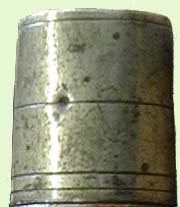
From 1829 to 1837, Asa Hopkins, a clockmaker in Litchfield, Connecticut, made "woodwinds." His son also did, in the Naugatuck Valley of Connecticut, in an area known as "Fluteville." Asa's grandson, Edward Hopkins, made fifes in Troy, New York from 1843 - 1844. One of his fifes, marked "Hopkins," with "Troy" beneath, is in the next photo.

William Horstman, 1790-1850, founded a company that sold military uniforms, etc. which was renamed 1859 as Wm. Horstmann & Son. Horstmann Bros was founded in 1860. This is a Horstmann Bros Bb fife courtesy of Chris Nelson.



Walter A. Crosby lived and worked in Boston from 1828 through 1872. To my knowledge, there are few of his fifes in existence; four? are in the Library of Congress. I know of three or four others and will have photos as soon as possible. The conical ferrules were made from a single sheet of metal, formed to a tapered cylinder, and soldered along a seam that ran the length of the ferrule. They are marked, "W. Crosby - Boston" or W.A.Crosby - Boston." He used no other marking. One unique characteristic of at least the early Crosby fifes is in the way the bore was cut. Apparently, the tooling available was of insufficient length to cut the bore in one pass. It would be cut from one end, the fife would be reversed on the lathe, and it would be cut again in the opposite direction. Exact alignment was virtually impossible, so, in some, if not all, a visible step can be observed near midpoint when the internal bore surface is examined. Below is a Walter Crosby fife with tapered ferrules using a solder joint. It is often said that Crosby made many instruments that were used during the Civil War. However, if this were so, why are there so few available today?

Here
are two marked Walter Crosby fifes that belong to a Connecticut collector:



At
first glance, looking at the photographs, one would think that an original Boston
Crosby would be indistinguishable from a much more recent George Cloos - Crosby
Model. Nothing could be farther from the truth! When held in the hand, the difference
is apparent. This fife is unbelievably slender in configuration when compared
with any other fife in existence! I could identify one with my eyes closed. The
other oddity for the period is that the finger holes vary in size.
To further cloud the issue, another Crosby Model was made during the period 1861 to 1865 by Granville - Draper. It also had the slender geometry of the Walter Crosby - Boston fife. It is marked "Crosby - GD." Steve Dillon has excellent photos here.
A New York musical instrument maker, Firth & Hall, was founded in 1820 by two apprentices who studied under flute maker Edward Riley. A fife by his son, Frederick Riley, 1845-1851, is below (Note that both brass ferrules are of equal length) they have seams and are scored 2 +1 +2. Courtesy - Steve Dillon.: William Hall (1796-1874) and John Firth (1789-1864) each married one of Riley's daughters.

In 1833, Firth & Hall later took in Mr. Sylvanus B. Pond (1792-1871) and changed the firm's name to Firth, Hall & Pond. Below is a Firth, Hall & Pond fife, courtesy of Joe Whitney.

Here is another Firth, Hall & Pond fife that belongs to a Connecticut collector: The reinforcing bands, often referred to as "wedding bands," were installed to retard splitting of the wood. Walter Crosby also used the same approach on some of his fifes.
![]()
Here's another most unusual Firth, Hall & Pond, courtesy of Chris Nelson. Notice that the ferrules are of equal length. It doesn't bear the normal 2 +1 +2 scribing lines. It has 2 +2 scribe lines and is marked, "FIRTH HALL & POND - 1 FRANKLYN SQ - NEW YORK." (Not clear in photo, but clear to naked eye.)



When Hall left in 1847, to found Hall & Son, the name of the old firm became Firth, Pond & Co. In 1850, William Hall went into the business of making pianos, although his son continued to make some fifes. In 1875, the Hall & Son firm was sold to Ditson. Below are a few fifes by Firth Pond & Co., courtesy of Joe Whitney.
![]()
![]()
![]()
Another Firth, Pond & Co fife from Chris Nelson is below.

Here is a William Hall fife, pitched in "C." (Krug Collection):


The fife below is from William Hall & Son, New York, courtesy of Chris Nelson.
![]()

 2 +1+2 scribing.
2 +1+2 scribing.
Firth & Pond fifes were commonly made from rosewood with either brass or German silver ferrules. "German" silver contains no silver; it is an alloy of Copper, Zinc, and Nickel. The company also made fifes with long tapered ferrules. These were made from a single piece of metal, which was wrapped over the wood and "dimpled" with a punch to hold it in place. No solder was used, but an adhesive was frequently applied. One very common characteristic was that the tail ferrule was a bit longer than the head ferrule. Except for the equal-sized brass ferrules, the fife below might be a Firth, Pond Co. It may also be a Klemm. My guess is that it is the latter because of the 1 +1 +2 scribing on the ferrules.

Hall used ferrules of brass, occasionally German silver, and made his fifes from boxwood and rosewood. He also used a bit of trickery, shaping them on the lathe so that they were broader near the blow hole, tapering down to the tail end, suggesting that they had a conical bore, which they did not. This became a common geometry used by many makers. Below is a fife by William Hall, & Son.

In 1863, John Firth went into the woodwind business with his son, Thaddeus. The firm was named Firth, Son &C. They made fifes, all unmarked, until 1867 when the business was sold to Oliver Ditson, a music publisher and purveyor of woodwind, brass and stringed instruments. If the name of Ditson doesn't ring a bell, one if its employees, John Haynes, later took over the company. Haynes is a name easily recognized by all flautists today. Below is a Ditson Bb fife, courtesy of Ron Peeler. It plays far better than any fife I have ever tried that was made prior to 1867.
![]()
In order to make more sense of this Firth, Hall, Pond, Ditson sequence, see the link at:
http://www.mcgee-flutes.com/Firth&c.htm
George Cloos arrived in New York, at age 17, in 1851. According to the ship's manifest, his training was as a "joiner," a talent used in the building of wooden houses. Since the majority of new housing at the time was built of brick, Cloos had to find another way to make his living. He somehow made the jump from precision carpentry to musical instrument manufacturing. The George Cloos Company produced primarily piccolos, flutes and clarinets, and later fifes, in a shop in Brooklyn, NY from 1862 until 1946. Since part of this period covers the latter part of the Civil War, it is barely possible that he made some fifes that were used during that conflict. There is no evidence that Cloos ever had a government contract to provide fifes. I have heard one claim that a particular fife was a short-ferruled Cloos of Civil War vintage. I had never seen a short-ferruled Cloos fife until recently. Here it is:
![]()
It is 16 inches long, pitched in Bb and marked with a simple "CLOOS." The Cloos stamping is on an angle from lower left to upper right. The finger holes are essentially the same size, although the number one and number six holes are a bit smaller. The head ferrule is slightly longer than the tail ferrule, both of brass with 1 x 1 knurling. The wood appears to be what was then called "cocoawood." The ferrules have dimples, meaning that they were set with a punch. This was commonly done with seamed ferrules. The brass appears to be seamless. However, the seams of some instruments were often so well-polished as to hide a seam. Is this the mysterious missing link, the famed "Civil War" Cloos fife? I don't know. Most of his post Civil War fifes had long, tapered ferrules.
My very good friend, Steve Dillon, has done a masterful job of resolving the question of the "Civil War Cloos / Crosby Fife." Read about it here:
There was a short-ferruled Cloos fife in the company's catalogs of the 1920s and 1930s. It was the least expensive in the line and was probably a low budget item sold to those who could not afford the Crosby Model. Here is another one that belongs to a Connecticut collector. I know of one in San Francisco, one in Massachusetts, and another in New Jersey, and there are probably more.
![]()

After discussing these fifes with five of this page's contributors, it was all agreed that these fifes were all in absolutely pristine condition, too good to to date to the 19th century. They all had the slanted marking and simple fingering system. In all probability, they were the low budget fife produced by Cloos in the 1920's, while the Crosby Model was the premium fife. It was a learner's instrument, the equivalent of sorts to the black plastic one used today. I guess it isn't the hypothetical short-ferruled Cloos fife of Civil War legend. It might be where the story actually originated. There probably never was such an instrument.
George
Cloos' son, Frederick, joined the business before 1900, along with a William Cloos,
a flautist who was George's eldest son. Frederick supervised the clarinet making
and William, the flutes, piccolos, and fifes. After that point in time, the marking
was changed to simply "CLOOS." A few rare ones may also have the word,
"IMPROVED," stamped on them. In 1915, George Cloos died and Frederick
took over, moving the plant to a larger facility, also in Brooklyn, New York..
The
early Cloos fifes were marked with A "G" superimposed over a "C"
with karat marks (< >) on both sides, as below. I hope to eventually fill
in the gaps in the sequence.
CLOOS or GEO.CLOOS

CLOOS
/ GC
(Note seam on ferrule)




CLOOS / CROSBY
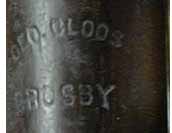
CROSBY/GC (small letters on the Crosby)


George Cloos/GC/Crosby (large letters)
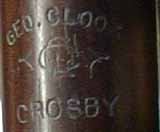
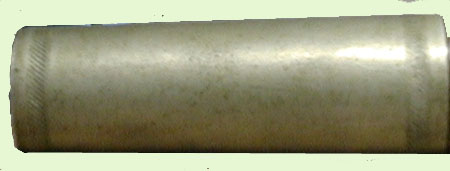
Crosby/GC/George
Cloos (large letters)
Penzel - Mueller

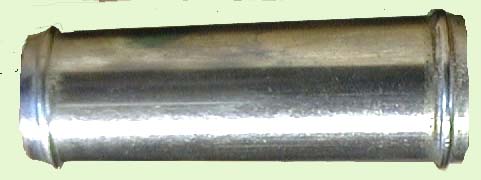
"CROSBY
MODEL" is stamped on the top of the tail section.
Below
is an early Cloos Bb fife with no Crosby designation, marked "GEO
CLOOS." Note that the finger holes are simple-system (uniform in size). Since
seamless, tapered ferrules began some time after 1869 and the varying finger hole
diameter Cloos began probably before 1888. 20th century Cloos fifes were marked
with "GEO CLOOS" in an upward-curving arch, with "CROSBY"
beneath. I have yet to determine when the "CROSBY" designation was first
applied to Cloos fifes, but it was probably some time around or before 1902, possibly
as early as 1868..


Here
is a rosewood Cloos Crosby with simple fingering and also its mark, pitched in
"C".



Here's a blackwood Bb Cloos Crosby with simple fingering and its mark:
![]()

Below is a two- piece fife belonging to Chris Nelson, made by George Cloos that is unlike those made from 1934 through the '40s.
1. It is pitched in
Bb and plays very poorly.
2. It has uniform finger hole diameters.
3.
Where the two-piece Cloos / Crosby had a brass tuning slide on the embouchure
hole end, this one has a turned wood section on the fingering end, wrapped in
thread.
4. The most interesting part is the nickel-silver band at the joint,
which is 1 - 1/2 inches long! The later 2-piece Cloos fifes had a much narrower
band.
5. Ferrules appear to be normal Cloos, seamless, tapered types,
The one on the embouchure end is 1-1/2 in length. The one on the other end is
1-5/8 in long. They are undamaged and appear to have been made that way.
6.
The stamping is pretty standard GEO. CLOOS, with GC maker's mark beneath, but
under that is lettered "L P" in quality lettering. "L.P." may mean "Low
Pitch." It plays a bit better in the bottom octaves.
7. It appears to
be made from Ebony or Rosewood, very dark. It has a very slight reddish tinge
to it, so it is probably made of Rosewood.
Steve Dillon has ventured an opinion that it was made in the first quarter of the 20th century. Steve has "about 5 of them."

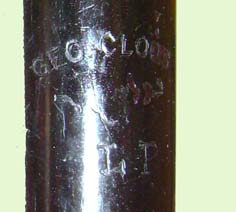
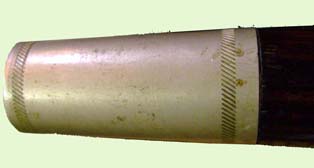

The "C" fife below is unmarked and obviously designed to have that "Crosby" appearance. It is neither a Cloos nor a W. Crosby product. It is marked "5th VT." The ferrules are scored and shorter than Cloos or Crosby.

A
significant characteristic of the Cloos fifes is that the design on the ferrules
is knurled rather than scored. Instead of a line pattern cut on a lathe, the design
is machined in such a way that the metal is compressed and molded by a machine
tool. The knurling on the Cloos ferrules changed over time:
On
the early Cloos fifes, the pattern was quite simple. ![]()
On later models, it was more precise. 
Over the years, I have often heard speculation that George Cloos apprenticed under Walter A Crosby, but there has never been sound confirmation of this. There is evidence that Cloos employees visited Boston while Crosby was still living. Statements that Cloos owned the Crosby company are false. One story is that a Drum Major at the Governor's Island School for Musicians named Crosby specified a certain fife design. There is no evidence of any drum major by that name ever serving at Governor's Island or any other Army music school. My view is that, because of the tapered ferrules on the later Cloos fifes and their similarity to the tapered ferrules of the original William Crosby - Boston instruments, they were designated "Crosby Model." Precisely when this occurred remains an open question. The early Cloos fifes with simple fingering and simple knurling patterns had tapered ferrules, but they sometimes had seams.
To make Cloos-related matters even more confusing, here is a most unusual fife in the Krug collection. It is simply marked "Cloos." Pitched in D, it has an embouchure plate, simple finger holes and short ferrules. I haven't been able to locate it in any of the Cloos catalogs I have seen. It could be quite old. It could be newer. I simply do not know.

Similar in many ways is this fife, except it is pitched in "C." Based upon the scribing lines on the ferrules, the engraving on the embouchure plate, etc. I would suspect that the second fife is a Cloos from around 1880 like the marked one above. However, the finger holes on the top fife are in a straight line. The bottom fife doesn't show the precision in alignment of the holes that one would expect from Cloos. Inconclusive.

The Cloos fife below has simple fingering, is marked "US 62," and is pitched in "C." Probably postwar.
![]()
One cannot study the history of the fife without discussing the flute because improvements to the flute normally predated the fife by as many as 30 years. Charles Nicholson (1795-1837) was a virtuoso flautist, often referred to as "Iron-Lip." He made experimental changes in flute design, mostly by enlarging some of the tone holes of the instrument. History can be most confusing and there is even some controversy on this subject. Opinions from some quarters say that his father, Charles Nicholson the Elder, made these alterations. In Nicholson's A School for the Flute, published by Firth & Hall in 1836, there is mention of the company using Nicholson's (the Younger) methods in the design of flutes. In any event, Nicholson's inordinate musical skills are said to have inspired Theobald Friederich Boehm to alter flute design with lasting flute design changes that are as functional today as in the 19th Century.
Theobald Friedrich Boehm (1794 - 1881) was a Bavarian goldsmith and musician who tinkered and experimented for most of his life with methods to improve the common flute. He eventually developed what is known today as the "Boehm System," which is used in the design of virtually all woodwinds today. The fruit of his labors was introduced at the Paris Exposition of 1855. Like all new technology, it took some time to migrate to the making of other flute manufacturers. This probably occurred around 1888 - 1890. The sound characteristics were major: ease of sounding, linearity of tone, responsiveness, and much higher volume. His first patent, in 1847, defined a new design for flutes that had quite large finger holes, followed by a more comprehensive one in 1867, which largely dealt with keys. However, the new design was far from universally accepted; many flute makers continued to use the simple-system until well into the 20th century because some flautists refused to accept the different sound of the instruments. An accomplished fifer who is playing a genuine, simple-system Civil War fife, even one in good condition, won't be heard any great distance and will tire easily.
Is there a connection between the changeover from uniform hole diameters of the simple system to the "new" system of varying hole diameter and the Boehm or Nicholson design? The finger hole sizes of the Boehm system are significantly larger than those of the Nicholson design. It is probable, if there is a connection, that most late 19th century fifes were influenced far more by Nicholson than Boehm. The timing demands more of an explanation than simple coincidence. It is generally agreed that most fifes with varying finger hole diameters are definitely post Civil War, regardless of whether or not they are attributed to Nicholson or Boehm. However, some early 19th century fifes had varying finger hole diameters, possibly because they were fabricated by piccolo makers. Cahusac and Astor had varying size holes, as did the Walter Crosby-Boston fifes. The few extremely old but unverified fifes that I have seen personally have had uniform sized holes, as do the Callender. .
During the Civil War, there were any number of fife makers who produced instruments that all looked pretty much the same and were seldom marked with the maker's name, if anything at all. They were all cylindrical bore instruments with ferrules that were short; some had long ferrules. Most ferrules bear score lines in varying patterns. This may hold some promise as a method of identification. They all had the uniform finger hole diameters of the simple-system. This description was specified by the Quartermaster of the U.S. Army until at least 1890. To add to the confusion, in 1912 the army began to specify "Crosby-type" instruments. Was this because of the Cloos - Crosby Model? I can't say for certain but it is probable. The Cloos had become quite popular by then..
If any of my visitors have procured a Cloos fife with the understanding that it was played during the Civil War, don't be disheartened. You are the owner of one of the finest fifes ever made, and one that will always gain in value, even without a Civil War connection. I know of no experienced fifer who would ever disagree with that statement. They would probably offer to buy it. Treasure your Cloos, keep the bore well oiled, and it will last for another century or more. Above all, play it and enjoy it. The Cloos was the progenitor of the famed Ferrary fife, which is still in great demand. Although it was extremely popular and remains so, that fife was never produced in the amazing numbers that the Cloos-Crosby was.
Let's take a close look at your fife. Does it have short, cylindrical ferrules? If so, are the finger holes uniform in diameter? If the answer to both of these questions is "Yes," it is likely that you have an early fife, possibly from the Civil War period and maybe even before. If it has long ferrules, does it have a seam and "dimples" or a solder joint that runs the length of the ferrules? Use a magnifier if necessary. The marks can be difficult to see. If "Yes," and the finger holes are uniform, it could be from the Civil War period as well.
If the finger holes are all the same size, take a closer look. Is the spacing between the third and fourth hole a bit greater than the other holes, giving the subtle appearance that the holes are actually in two groups? If so, it would indicate that the fife may have been made sometime between 1840 and 1860 or so. If not, it could be from either before or after that period.
Let's examine a fife from my collection. When I obtained it, the fife was badly warped and had some evidence of early cracking. I placed a cork in the tail end and filled it with Bore Doctor, letting it soak for about a month in a horizontal position. The warp is virtually gone now and there is little evidence of any cracking. It appears to have been made from rosewood. There is no visible maker's mark. The head ferrule, made of what appears to be German silver and is engraved with the name, "Jos. Ahern," about whom I know absolutely nothing.

The distance between the blow hole center and center of the last finger hole is about 10-7/8 inches, so it is a Bb fife. It appears to be made from rosewood. The ferrules are short and cylindrical, the tail ferrule being slightly longer, probably made from German silver. If anything softer were used, they would show much more wear, dings and dents. They are attached by "dimpling" with a punch in two locations on each ferrule. There is no maker's mark evident, even under ultraviolet light.
Image quality in this photo is not great, but a necessary tradeoff for the finger holes to be visible. Notice that the distance between the third and fourth hole is greater than between the others. This denotes that the earliest date of manufacture would be around 1840 and on up the the late 1850s.

It would be convenient if Jos. Ahern could be located among the ranks of Civil War musicians, but I had no luck using this method.

However, if we look at the two photos below, the one on the left is a ferrule from a confirmed Firth and Pond and the one on the right is the unidentified "Ahern" fife.
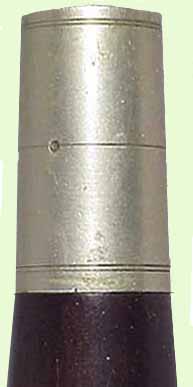
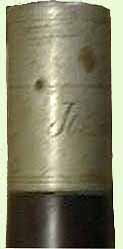
The scoring pattern is such that there is a double score on both ends of the ferrule and a central score line. The central line passes directly through the dimple in both instruments.
Conclusion: The rosewood would eliminate Callender because he commonly used boxwood. Klemm used both, but the geometry of the Klemm ferrule appears a bit shorter and the scoring on the Klemm is 1 - 1 - 2. The finger hole spacing places the fife between maybe 1840 and 1870. It is too early to be a Hall, but not too early for Firth & Hall, who also commonly fixed the ferrules to the wood using a punch. The instrument has some of the look of an Eisenbrandt, a fife fairly common during the War of 1812 that was made in Philadelphia. However, those fifes had an larger diameter at the blow hole and a significant taper all the way to the tail ferrule. I don't have an Eisenbrandt to compare it with. Initial suspicions were that it was a Firth & Hall. Comparison of the ferrules confirmed that is probably from that maker.
If your fife has long, tapered ferrules, and has no solder or butted ferrule joints, it was made after 1869. If the finger holes vary in size, it was probably made after 1888-90, but this date is only a hunch on my part. Some early fifes made by European makers who also made piccolos had a varying finger hole system as well. It was some time between 1890 and 1912 when Cloos added "Crosby Model " because of the similarity to the tapered ferrules of the original Walter Crosby - Boston. His firm and that of Crosby were two separate, unrelated businesses.
Let us look at another fife. It is unmarked, simple fingering, and I have no idea where I got it, but I have quite a few just like it.

This one is essentially identical to the one above, but marked with "U.S. 6th ME, Bb, 1857"

And
another unmarked rosewood with simple fingering:

I have more of them.
These fifes are as close to a "generic" Civil War instrument as there is. None bear a maker's mark, yet they often have some military designation and they abound in collections throughout the country. They all have brass ferrules bearing two knurled lines on them as imaged in the close-up. Although one might think that they are potentially "bargain" Cloos fifes from the 1920's, close comparison shows the knurling to be inboard from the edges of the metal. The "bargain" Cloos fifes had knurling that was very close to the edges.
The first two fifes measure about 10-7/8 from blow hole center to the center of the last finger hole, so they are Bb instruments, and the bottom one is a "C." They all have the simple system of fingering. The distance between the 3rd and 4th hole hints at being a bit greater than the others. There is no maker's mark on them. At first glance, one would think that they are old fifes, maybe between 1840 and 1860. Now, let's examine a ferrule.
 NOTE
SEAM>
NOTE
SEAM> 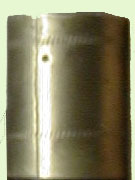
The ferrule is brass, and has a seam that may be seen on the right side in the photo above. It appears old to me. The ferrule is secured by "dimpling." A dimple is visible in the above photograph. That sounds old, too. However, the ferrule does not have score lines on it. It has "knurled" or machined lines on it much like George Cloos did much later on. How old is it? I don't know. Who made it? I don't know the answer to that one either. Is it one of the mysterious Civil War Cloos fifes that may or may not have existed? (Excitement builds!) I don't think so. Maybe they are simply well-worn examples of the 1920's bargain Cloos fifes. Even after complete restoration, this fife is miserable to play and doesn't even hint of ever being any better in its prime. George Cloos would never have allowed something like this out of his shop. I suspect it was a late 19th century low-bid government contract item. Some things never change.
The above three fifes may well be unmarked Klemm instruments, produced in great volume during the Civil War, many of them made in Germany. But that theory doesn't account for the knurling.
Here's another unknown fife. I have a bunch like this in Bb, C, and one in A. The ferrules are short, cylindrical, seamed, with a center scribe line, different from the three fifes above. There are three scribe lines and no knurling like in the three preceding it. . Dimple is on the middle scribe line. The dimple is in on the center score line, like Firth & Pond, but the ferrules are equal in length, like the William Hall & Son. However, the scribing pattern is 1+1+2, so they are probably unmarked Klemms.
![]()

Another more unusual fife was made by the John F.M. Joerdans Company of New York City. As near as I can tell they were made only in 1863 under contract to the U.S. Army. About 2000 of them were made of Cocoawood. It is possible that they were finished with Linseed oil, which oxidises to a black coloration. The ferrules bear no scribe lines.

Very similar to those above, the next fife (below) is a "C" fife that has one obvious difference, in that the wood protrudes a bit beyond the edges of the ferrules. This fife also has a bit of a provenance. This is what the the owner's father had to say:
"Yes," my father continued, "my dad told me along time ago, well before he died, that it belonged to...well...I guess...it would be your Great, Great, Grand Father Nathaniel Brown Akers but nobody I've ever known could even get a sound out of it." At this point my mouth was gaping open, as you can imagine. So the next day we went down and dug it out of the trunk. Then I stood in the basement of my parent's house and for the first time in probably over 100 years, it sang out "Yankee Doodle". It has no date, manufacturer, key, label or name on it anywhere. But that's okay by me, since it hardly has a blemish either. I have attached a few photos. I have no exact information about Nathaniel Brown Akers' birth or death date but he did live in Virginia. From what I can tell in the family's records, Nathaniel Brown Akers' son (my great grandfather) was born in 1851 and was Nathaniel's fourth child. So just guessing it must have been made probably before 1851. If Nathaniel started playing it as a child, or if it was used when he acquired it or both, then the age could go back well before this date. The brass ferrules are short and have a single dimple from a punch on each to help hold them in place. There are small pencil marks under the finish for each hole where someone marked it on a lathe before drilling. These are only visible in very bright light. The brass has two small rings on each ferrule that appear to be decorative and are somewhat visible in the photos. There is also a small thin line in the brass ferrules running along the main axis of the fife, but I can't tell if this is decorative or a seam where the brass was rolled into shape."
![]()
The
seam in the ferrule is quite obvious. The design is difficult to match anywhere.
The provenance is quite believable.

The fifes get stranger as we move along. Here is a "C" fife with no maker's mark, labeled "3rd VT." The ferrules appear to be crudely made. Not much of a taper or swelling around the embouchure hole. The wood could be Cherry:

Here's another unknown, unmarked, with simple fingering system. Ferrules are smooth with no score marks.

Another fife Ron Peeler showed to me at Deep River Ancient Muster - 2005 is below:

It is a bit dark for Boxwood or Coccus, but doesn't display the complex grain usually seen in "Cocoawood." But the story gets complicated when one examines the markings on the instrument:

I think we can assume that it is pitched in "C." I have no idea of what the two "sunburst" characters mean, nor the "O." If anyone out there has seen this pattern before and can shed some light upon it, please let me know.
In the late 19th century, William Bauer, 1857-1932, was an acoustician, instrument designer, and president of the Julius Bauer company in Chicago. Below is Wm. Bauer fife. It is pitched in Bb, plays relatively well, and as an odd scribing pattern on the ferrules: 1, knurl, 1 +1, knurl, 1. It appears to have a simple finger hole design with all holes of common size except #5 which is much larger than the others. I don't know much more than that about the instrument. Courtesy - Chris Nelson.
![]()


. Here's another unknown Bb fife. The decorative metal band may make it appear to be a two-piece fife. It is NOT! The instrument is unmarked, and it is just another member of the multitude of fifes by unknown makers. Ferrules are bright metal, cylindrical, and finger holes are simple system.
![]()
In 1946, about the time when this writer first began to play, Frederick Cloos was getting on in years. The Cloos fife was considered by most to be the finest fife made. The company was then sold to the Penzel Company, a maker of other instruments. It picked up the Penzel Mueller name, possibly because Cloos had many German craftsmen in his employ. Penzel-Mueller continued to use the Cloos / Crosby marking. On some fifes, notably the two-piece, the Penzel & Mueller name is stamped in small lettering. Most people who have played them would agree that the quality suffered. I agree. The company went out of business 6 years later. Below is a Penzel & Mueller 2-piece fife from my collection.

This fife has the George Cloos hallmark in the usual location, on the head section, just below the blow hole.
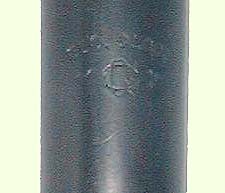
"Crosby Model" is not in its normal location. It is near the joint on the top side of the tail section, where it states, "Key of Bb" Beneath that, is says, "Crosby Model." On the opposite side of the head section, above the joint, it says, "Penzel-Mueller, New York."
I often hear from people who say that their Cloos fife was played by their great, great grandfather "during the Civil War." The fife has seamless, tapered ferrules and varying finger hole diameters. Is this possible? Probably not! Here's a possible explanation:
Nothing binds the minds and hearts of men more than serving in combat together. After the Civil War ended, veterans went home to their families and homes, keeping in touch with their comrades in any way possible. Some bore war-related injuries and others had difficulties collecting well-deserved pensions. An organization was founded in Decatur, Illinois in 1866 with membership open to veterans of all the armed forces who served from between April 12, 1861 and April 9, 1865. It was called the Grand Army of the Republic. The organization set up local chapters not unlike the Veterans of Foreign Wars today. They set about providing assistance in healthcare for wounded veterans, pension benefits, etc.
As time went on, they occasionally held encampments, often on the sites of various battlefields. At the encampments, awards were frequently given to some of the old soldiers. Fifers often received fifes and drummers would receive sticks or drums. It may be true that one's ancestor fought and played the fife during the Civil War, but if his fife has varying finger hole diameters and seamless, tapered ferrules, he probably obtained it after the war was over. Since Cloos was producing the finest fifes available at the time, it can be assumed that many veterans quickly discovered that they were far superior than anything they had played during their military service and purchased them. They may have a name or a unit engraved upon it, but that doesn't change the facts one whit.
At the end of the Civil War, bonds between musicians often grew stronger, leading to the growth of the fife and drum corps. movement in the United States, particularly in New England, many of them spinning off from the Grand Army of the Republic. Since the Civil War veterans all agreed that the Cloos fife was far superior to anything they had played during their wartime service, George Cloos began to produce them in large numbers. It is quite possible that some of these corps. fifes picked up a false Civil War provenance along the way. Many were, in fact, owned by Civil War veterans; they were just not played during the war. The majority of Cloos fifes were Bb instruments, which is probably why the Bb variety is so very common today. Since many of these fifes were owned by Civil War veterans, they are assumed to have been played during the Civil War when, in fact, they were not. They were played by Civil War veterans after the war was over.
Based upon the vast number of true Civil War fifes in various collections today, about 50-60% appear to be pitched in C with Bb fifes making up virtually all of the balance. Near the end of the Civil War, George Cloos began to make fifes in quantity which were scooped up by veterans in the Grand Army of the Republic. Some Cloos fifes bear markings as to specific military units. They may or may not have been actually used during the war but evidence is to the contrary. The owners may have simply marked them afterward. The majority of these postwar fifes were in Bb. I have seen many a Cloos fife pitched in C or Bb that have military markings, which might lead one to believe that it was a "Civil War" Cloos. However the long, tapered ferrules are seamless, so the age is still a mystery.
Civil War fifers from the Grand Army of the Republic then began to teach their children and others to play, and fife and drum corps. were organized, particularly in the northeastern United States. Associations were soon founded in Connecticut (1885), Massachusetts, New York and other states and competitions began. For various reasons, the fife of choice was the Cloos-Crosby pitched in Bb. This is the principal reason why the Bb fife is so much more popular today. The Bb fife has a tonal quality that is much more pleasing as well. The C fifes can be somewhat raucous.
The only fife I have in my collection that I can actually date to a specific year is a Cloos Bb fife that was made in 1943. That was the year when the United States Mint produced a zinc-plated steel penny in an effort to conserve copper for the war effort. There were also restrictions on other metals. My Cloos fife has ferrules made of Bakelite, an early form of plastic mainly used in making electrical insulators! It was made in 1943.

So long as we are on the subject of unusual materials being used in fife making, I must relate the fact that one of my contributors to this page has a most unusual fife that is marked with "Cloos Crosby." The strange part of the story is that it was made from hardened rubber, which was a common material for many manufactured goods in the early 20th century. Confirmation of this comes from the fact that, near one ferrule, is has the words "MADE IN FRANCE." It was in the mid-1920s that the US government began to enforce an older law requiring the country of origin to be marked on imported goods. I also recall a fife that came up for bid a few years ago on an Internet auction site that was described as a "Civil War Cloos Fife" made from hardened rubber. My memory is a bit blurry, but I remember that the instrument was inscribed with the regimental name of a military unit from the Civil War, possibly from Maine. It sold for a lot of money! Bear in mind that such a regimental marking does not prove an instrument's age or value without significant additional information. It is no more than another piece of the puzzle. The fife that was made in France could have been no more that a copy, not unlike the knockoff "Rolex " watches so commonly worn today.
In August of 2004, when I was in the early stages of composing this article, I learned of another website dealing with the same subject that well deserves a visit, especially the part about buying a fife at an on-line auction. It is at: http://www.fifedrum.org/sjbaretsky/cgi-bin/Fifes/
Steve Dillon has also set up a great web page that deals with the subject of historic fifes. It is at: http://www.dillonmusic.com/historic_fifes/historic_fifes.html It is a very worthwhile resource.
I often see people spend vast sums of money trying to obtain a "genuine Civil War fife," most of the time never getting what they actually wanted and paying far too much for it. Had they somehow managed to obtain such a fife, they would, in all probability, discover that it didn't play very well, if at all. It probably did not play well when it was new and time has taken its toll. Even if there were an occasional truly genuine Civil War fife that, due to some accident of history or exceptional maintenance, did play well, there would certainly not be enough to go around. It is a Holy Grail of sorts. There is no such thing as a "Civil War look;" the fifes had many different designs and geometries.
However, I do very highly value the historical importance all of these wonderful old instruments that made such a significant contribution to the military history of our country. That is why, like many others, I collect them and display them in my home. They have served their purpose well. I provide them with a respectful, dignified retirement.
Note: as I stated at the outset, this page is a work in progress. If any of my visitors has any information to add or correct, please let me know. If anybody has photographs of instruments that are marked or have been validated to a high level of confidence, I would be most happy to post them here as a reference for others. Email Me
Many of the photos on this page were made under most difficult conditions, sometimes on a table at a muster field at night. I hope readers can provide me with some better quality photos.
Brains I picked in the composition of this page, so far, include:
Sue
Cifaldi
Steve Dillon
Jack Doyle
Pete Emerick
David
Graff
(great-great-grandson of George Cloos)
Jim
McCabe
Chris Nelson
Ed Olson
Ron Peeler
Joe Whitney
(C)EW Boyle, 2004